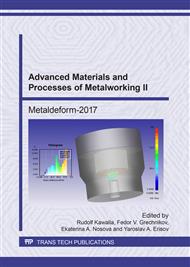p.3
p.10
p.16
p.22
p.29
p.36
p.48
p.56
Study and Build-Up of Deformation Zone at Cutting of Thin-Walled Tube by Torsion
Abstract:
Intensive development of Russian aviation and aerospace industries put an emphasis to the problem of quality of using materials and workpieces and to the value of technical and economical indexes in the context of planned production level [1, 2]. Waste-free technologies are preferred. Cutting by torsion or cutting by shear are preferable technologies if thin-walled tube cutting is the main blanking operation. Build-up of workpiece deformation zone plays an important role in the cutting process. Deformation zone determines stability of details during further processing and exploitation. An extended research was conducted about tube separation process using torsion with an active counterpressure. Some parameters was defined in the result of research, in particular: distribution of deformation zone along length and thickness of workpiece, angular deflection and compression force and workpiece heating temperature impact on build-up of whisker disposition in the cut zone. It allows identifying optimum compression force range and temperature conditions. Compliance with recommended practices allows conducting thin-walled tube separation simultaneously with build-up on the workpieces whisker structure that is fortunate for further pressure treatment and exploitation.
Info:
Periodical:
Pages:
16-21
Citation:
Online since:
July 2017
Authors:
Keywords:
Price:
Сopyright:
© 2017 Trans Tech Publications Ltd. All Rights Reserved
Share:
Citation:


